Health Education Report: Modifiable Risk Factors and Behavior
VerifiedAdded on 2022/11/25
|10
|1178
|206
Report
AI Summary
This report provides a comprehensive analysis of modifiable risk factors and their impact on behavior, particularly in the context of chronic illnesses and disabilities. The introduction defines modifiable risk factors and introduces a case study of Parker, a 19-year-old student with a medical history of anxiety, depression, asthma, and ADHD. The report outlines the factors contributing to Parker's behavior, including his mental health conditions and difficulties managing his lifestyle. It identifies the social cognitive theory as a relevant health behavior theory and suggests interventions for modifying behavior. The report also explores innovative and practical strategies, such as motivational care provided by nurses, and identifies person-centered care as an appropriate service to support patients. The conclusion summarizes the key findings, emphasizing the importance of understanding modifiable risk factors and implementing effective interventions for improved patient outcomes. References to relevant research papers are included to support the analysis and recommendations.

Health Education
Narrated
PowerPoint
Narrated
PowerPoint
Paraphrase This Document
Need a fresh take? Get an instant paraphrase of this document with our AI Paraphraser

Table of Content
• Introduction
• Main body
• Conclusion
• References
• Introduction
• Main body
• Conclusion
• References
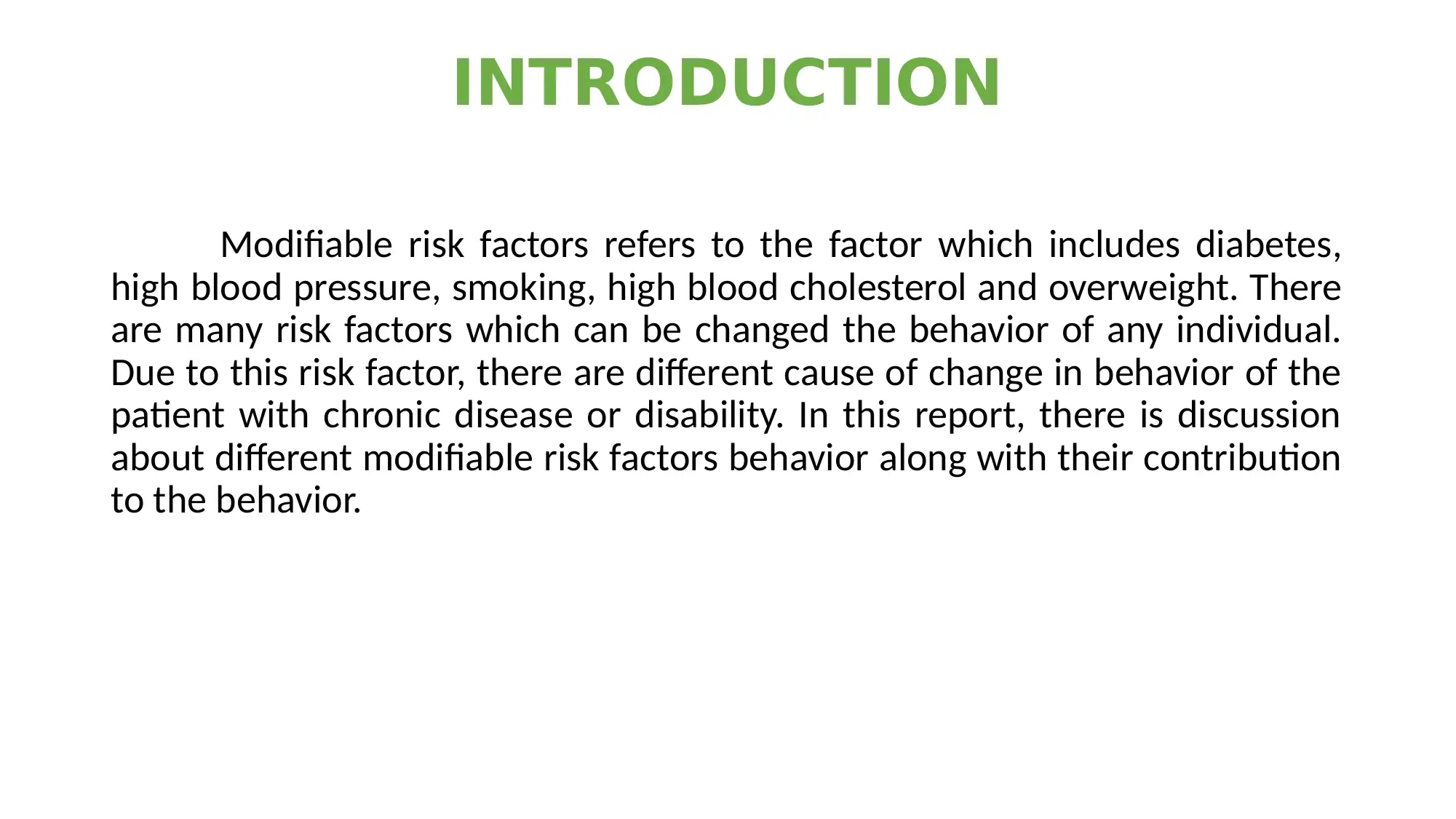
INTRODUCTION
Modifiable risk factors refers to the factor which includes diabetes,
high blood pressure, smoking, high blood cholesterol and overweight. There
are many risk factors which can be changed the behavior of any individual.
Due to this risk factor, there are different cause of change in behavior of the
patient with chronic disease or disability. In this report, there is discussion
about different modifiable risk factors behavior along with their contribution
to the behavior.
Modifiable risk factors refers to the factor which includes diabetes,
high blood pressure, smoking, high blood cholesterol and overweight. There
are many risk factors which can be changed the behavior of any individual.
Due to this risk factor, there are different cause of change in behavior of the
patient with chronic disease or disability. In this report, there is discussion
about different modifiable risk factors behavior along with their contribution
to the behavior.
⊘ This is a preview!⊘
Do you want full access?
Subscribe today to unlock all pages.

Trusted by 1+ million students worldwide
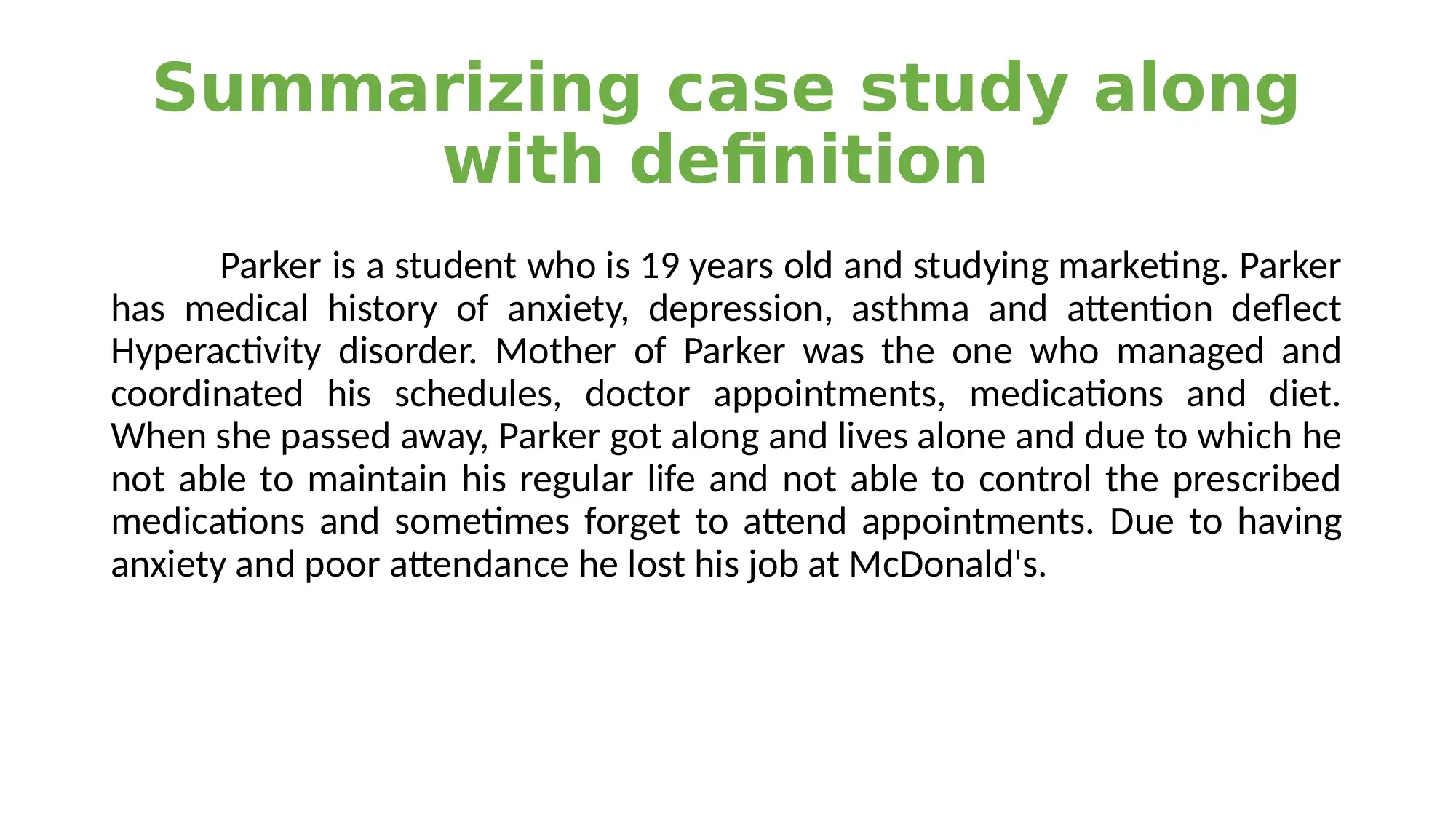
Summarizing case study along
with definition
Parker is a student who is 19 years old and studying marketing. Parker
has medical history of anxiety, depression, asthma and attention deflect
Hyperactivity disorder. Mother of Parker was the one who managed and
coordinated his schedules, doctor appointments, medications and diet.
When she passed away, Parker got along and lives alone and due to which he
not able to maintain his regular life and not able to control the prescribed
medications and sometimes forget to attend appointments. Due to having
anxiety and poor attendance he lost his job at McDonald's.
with definition
Parker is a student who is 19 years old and studying marketing. Parker
has medical history of anxiety, depression, asthma and attention deflect
Hyperactivity disorder. Mother of Parker was the one who managed and
coordinated his schedules, doctor appointments, medications and diet.
When she passed away, Parker got along and lives alone and due to which he
not able to maintain his regular life and not able to control the prescribed
medications and sometimes forget to attend appointments. Due to having
anxiety and poor attendance he lost his job at McDonald's.
Paraphrase This Document
Need a fresh take? Get an instant paraphrase of this document with our AI Paraphraser
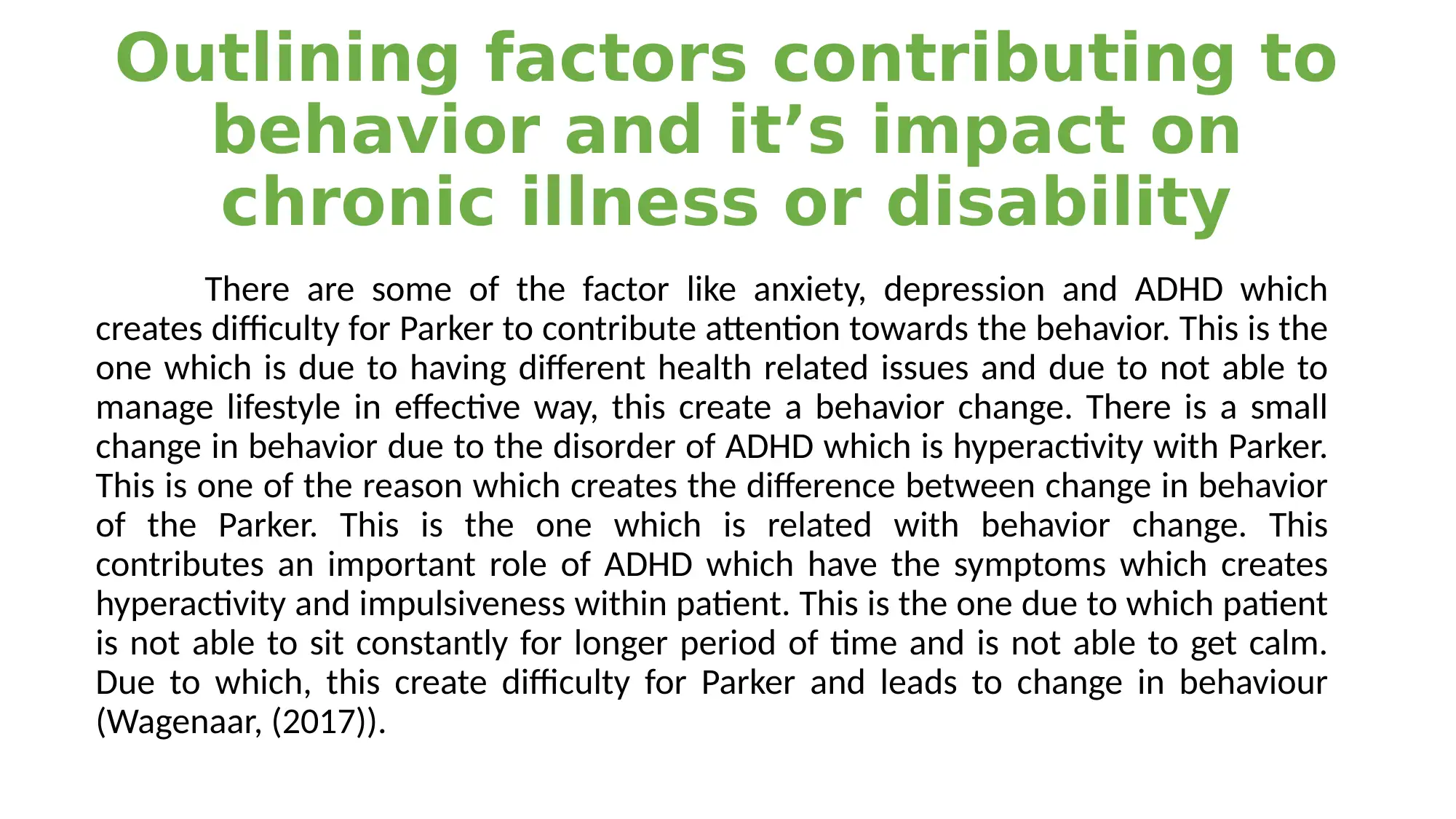
Outlining factors contributing to
behavior and it’s impact on
chronic illness or disability
There are some of the factor like anxiety, depression and ADHD which
creates difficulty for Parker to contribute attention towards the behavior. This is the
one which is due to having different health related issues and due to not able to
manage lifestyle in effective way, this create a behavior change. There is a small
change in behavior due to the disorder of ADHD which is hyperactivity with Parker.
This is one of the reason which creates the difference between change in behavior
of the Parker. This is the one which is related with behavior change. This
contributes an important role of ADHD which have the symptoms which creates
hyperactivity and impulsiveness within patient. This is the one due to which patient
is not able to sit constantly for longer period of time and is not able to get calm.
Due to which, this create difficulty for Parker and leads to change in behaviour
(Wagenaar, (2017)).
behavior and it’s impact on
chronic illness or disability
There are some of the factor like anxiety, depression and ADHD which
creates difficulty for Parker to contribute attention towards the behavior. This is the
one which is due to having different health related issues and due to not able to
manage lifestyle in effective way, this create a behavior change. There is a small
change in behavior due to the disorder of ADHD which is hyperactivity with Parker.
This is one of the reason which creates the difference between change in behavior
of the Parker. This is the one which is related with behavior change. This
contributes an important role of ADHD which have the symptoms which creates
hyperactivity and impulsiveness within patient. This is the one due to which patient
is not able to sit constantly for longer period of time and is not able to get calm.
Due to which, this create difficulty for Parker and leads to change in behaviour
(Wagenaar, (2017)).
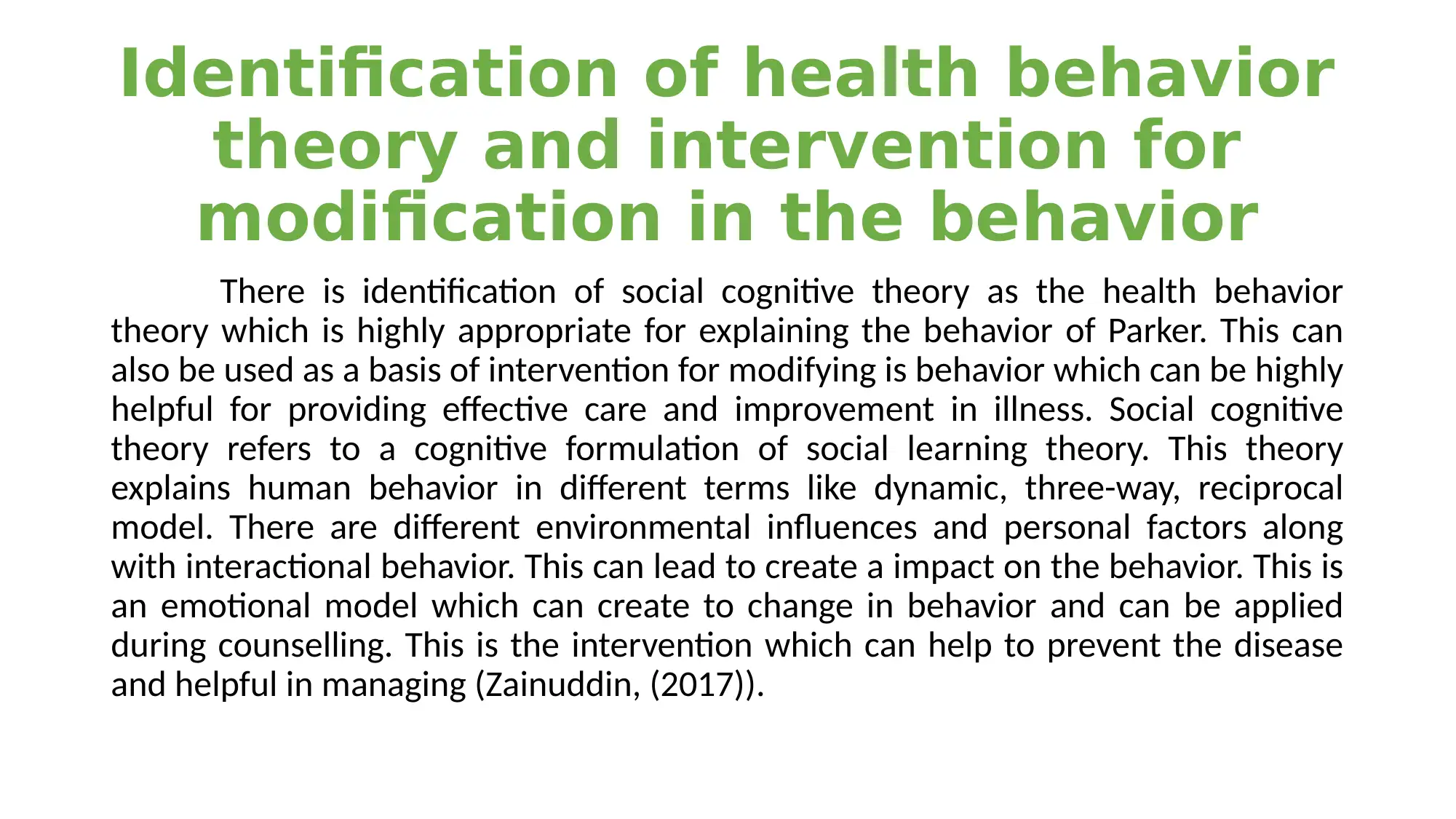
Identification of health behavior
theory and intervention for
modification in the behavior
There is identification of social cognitive theory as the health behavior
theory which is highly appropriate for explaining the behavior of Parker. This can
also be used as a basis of intervention for modifying is behavior which can be highly
helpful for providing effective care and improvement in illness. Social cognitive
theory refers to a cognitive formulation of social learning theory. This theory
explains human behavior in different terms like dynamic, three-way, reciprocal
model. There are different environmental influences and personal factors along
with interactional behavior. This can lead to create a impact on the behavior. This is
an emotional model which can create to change in behavior and can be applied
during counselling. This is the intervention which can help to prevent the disease
and helpful in managing (Zainuddin, (2017)).
theory and intervention for
modification in the behavior
There is identification of social cognitive theory as the health behavior
theory which is highly appropriate for explaining the behavior of Parker. This can
also be used as a basis of intervention for modifying is behavior which can be highly
helpful for providing effective care and improvement in illness. Social cognitive
theory refers to a cognitive formulation of social learning theory. This theory
explains human behavior in different terms like dynamic, three-way, reciprocal
model. There are different environmental influences and personal factors along
with interactional behavior. This can lead to create a impact on the behavior. This is
an emotional model which can create to change in behavior and can be applied
during counselling. This is the intervention which can help to prevent the disease
and helpful in managing (Zainuddin, (2017)).
⊘ This is a preview!⊘
Do you want full access?
Subscribe today to unlock all pages.

Trusted by 1+ million students worldwide
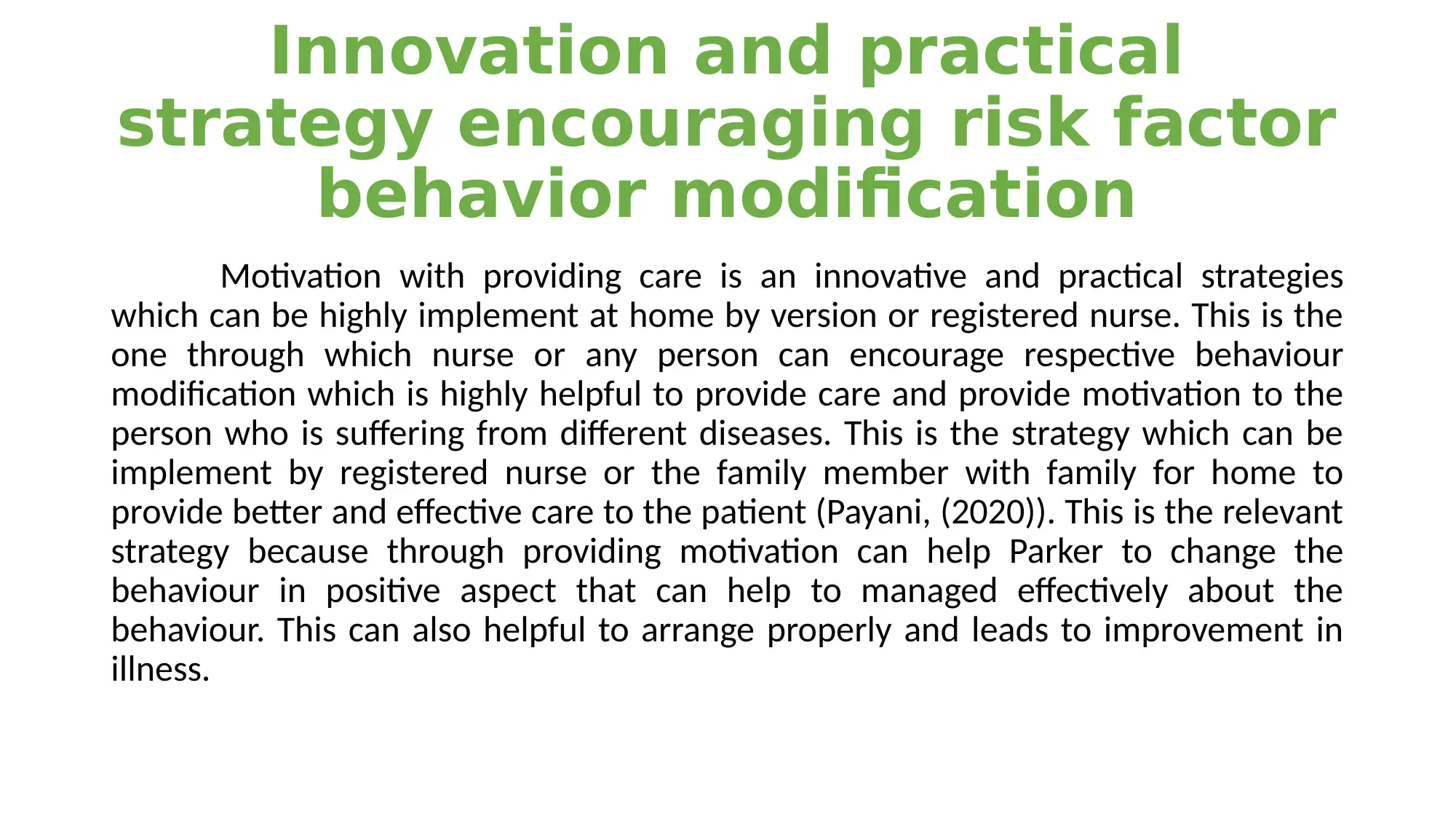
Innovation and practical
strategy encouraging risk factor
behavior modification
Motivation with providing care is an innovative and practical strategies
which can be highly implement at home by version or registered nurse. This is the
one through which nurse or any person can encourage respective behaviour
modification which is highly helpful to provide care and provide motivation to the
person who is suffering from different diseases. This is the strategy which can be
implement by registered nurse or the family member with family for home to
provide better and effective care to the patient (Payani, (2020)). This is the relevant
strategy because through providing motivation can help Parker to change the
behaviour in positive aspect that can help to managed effectively about the
behaviour. This can also helpful to arrange properly and leads to improvement in
illness.
strategy encouraging risk factor
behavior modification
Motivation with providing care is an innovative and practical strategies
which can be highly implement at home by version or registered nurse. This is the
one through which nurse or any person can encourage respective behaviour
modification which is highly helpful to provide care and provide motivation to the
person who is suffering from different diseases. This is the strategy which can be
implement by registered nurse or the family member with family for home to
provide better and effective care to the patient (Payani, (2020)). This is the relevant
strategy because through providing motivation can help Parker to change the
behaviour in positive aspect that can help to managed effectively about the
behaviour. This can also helpful to arrange properly and leads to improvement in
illness.
Paraphrase This Document
Need a fresh take? Get an instant paraphrase of this document with our AI Paraphraser
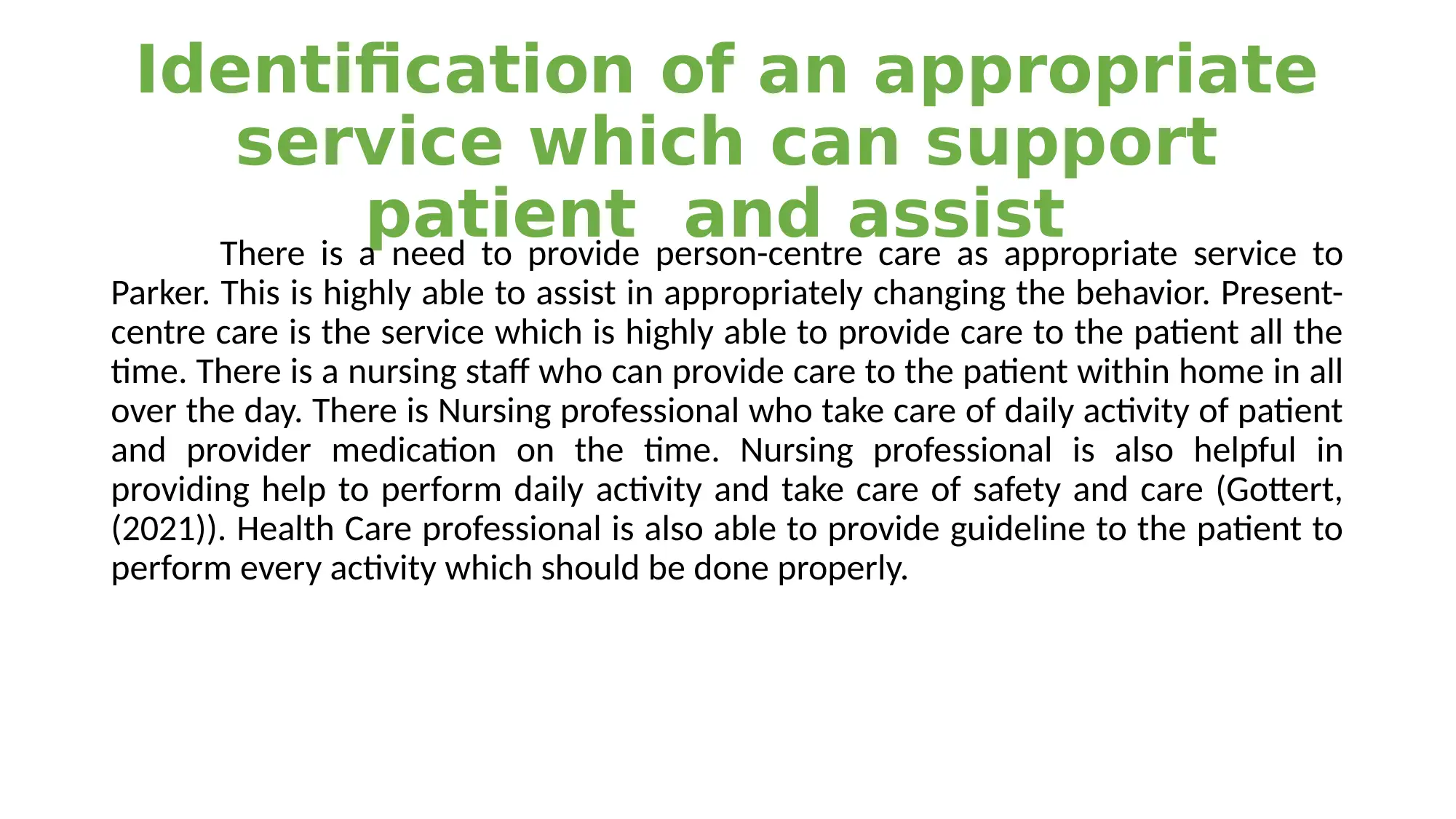
Identification of an appropriate
service which can support
patient and assistThere is a need to provide person-centre care as appropriate service to
Parker. This is highly able to assist in appropriately changing the behavior. Present-
centre care is the service which is highly able to provide care to the patient all the
time. There is a nursing staff who can provide care to the patient within home in all
over the day. There is Nursing professional who take care of daily activity of patient
and provider medication on the time. Nursing professional is also helpful in
providing help to perform daily activity and take care of safety and care (Gottert,
(2021)). Health Care professional is also able to provide guideline to the patient to
perform every activity which should be done properly.
service which can support
patient and assistThere is a need to provide person-centre care as appropriate service to
Parker. This is highly able to assist in appropriately changing the behavior. Present-
centre care is the service which is highly able to provide care to the patient all the
time. There is a nursing staff who can provide care to the patient within home in all
over the day. There is Nursing professional who take care of daily activity of patient
and provider medication on the time. Nursing professional is also helpful in
providing help to perform daily activity and take care of safety and care (Gottert,
(2021)). Health Care professional is also able to provide guideline to the patient to
perform every activity which should be done properly.

CONCLUSION
From above discussion, it can be concluded that there are different risk
factor which are modified payable for the behavior due to different respective.
There is change in the behavior of patient and can also impact on chronic disease
or disability. In this report, their discussion about the modifiable risk factor
behavior along with contribution to the behavior by different factors. There is also a
factor of chronic illness or disability due to behavior. In this report, there is also
discussion about identification of health behavior theory which can able to explain
appropriately about the behavior and related intervention. There is also a
discussion about Innovation and practical strategies that can be helpful in
implementation at home to encourage a risk factor behavior modification. There is
also discussion about the registered nursing role within this strategy. There is also a
description about appropriate service support which can able to assist register
nursing staff and the process of funding along with role of registered nurse.
From above discussion, it can be concluded that there are different risk
factor which are modified payable for the behavior due to different respective.
There is change in the behavior of patient and can also impact on chronic disease
or disability. In this report, their discussion about the modifiable risk factor
behavior along with contribution to the behavior by different factors. There is also a
factor of chronic illness or disability due to behavior. In this report, there is also
discussion about identification of health behavior theory which can able to explain
appropriately about the behavior and related intervention. There is also a
discussion about Innovation and practical strategies that can be helpful in
implementation at home to encourage a risk factor behavior modification. There is
also discussion about the registered nursing role within this strategy. There is also a
description about appropriate service support which can able to assist register
nursing staff and the process of funding along with role of registered nurse.
⊘ This is a preview!⊘
Do you want full access?
Subscribe today to unlock all pages.

Trusted by 1+ million students worldwide
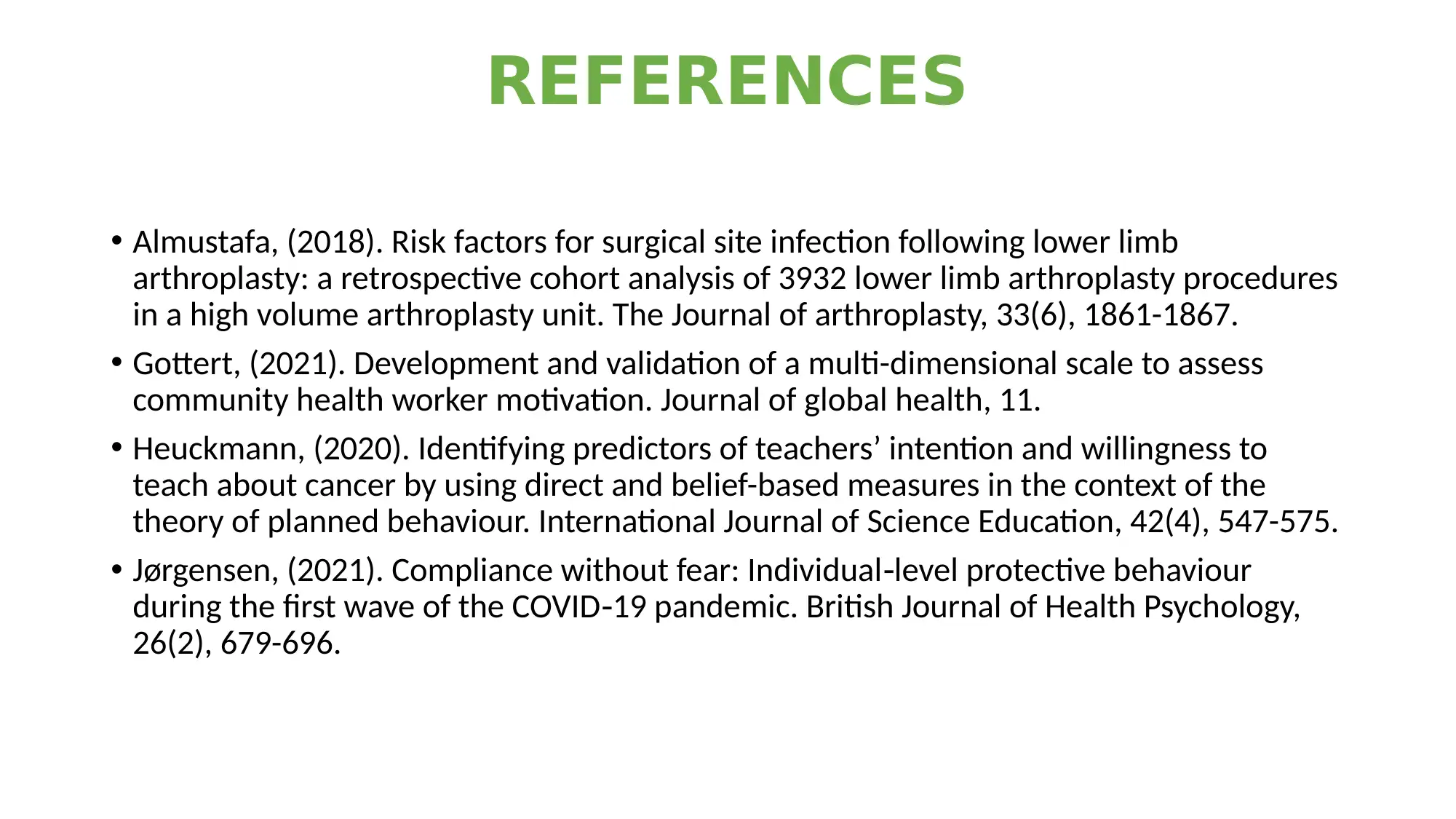
REFERENCES
• Almustafa, (2018). Risk factors for surgical site infection following lower limb
arthroplasty: a retrospective cohort analysis of 3932 lower limb arthroplasty procedures
in a high volume arthroplasty unit. The Journal of arthroplasty, 33(6), 1861-1867.
• Gottert, (2021). Development and validation of a multi-dimensional scale to assess
community health worker motivation. Journal of global health, 11.
• Heuckmann, (2020). Identifying predictors of teachers’ intention and willingness to
teach about cancer by using direct and belief-based measures in the context of the
theory of planned behaviour. International Journal of Science Education, 42(4), 547-575.
• Jørgensen, (2021). Compliance without fear: Individual level protective behaviour‐
during the first wave of the COVID 19 pandemic. British Journal of Health Psychology,‐
26(2), 679-696.
• Almustafa, (2018). Risk factors for surgical site infection following lower limb
arthroplasty: a retrospective cohort analysis of 3932 lower limb arthroplasty procedures
in a high volume arthroplasty unit. The Journal of arthroplasty, 33(6), 1861-1867.
• Gottert, (2021). Development and validation of a multi-dimensional scale to assess
community health worker motivation. Journal of global health, 11.
• Heuckmann, (2020). Identifying predictors of teachers’ intention and willingness to
teach about cancer by using direct and belief-based measures in the context of the
theory of planned behaviour. International Journal of Science Education, 42(4), 547-575.
• Jørgensen, (2021). Compliance without fear: Individual level protective behaviour‐
during the first wave of the COVID 19 pandemic. British Journal of Health Psychology,‐
26(2), 679-696.
1 out of 10
Related Documents
Your All-in-One AI-Powered Toolkit for Academic Success.
+13062052269
info@desklib.com
Available 24*7 on WhatsApp / Email
![[object Object]](/_next/static/media/star-bottom.7253800d.svg)
Unlock your academic potential
Copyright © 2020–2025 A2Z Services. All Rights Reserved. Developed and managed by ZUCOL.





